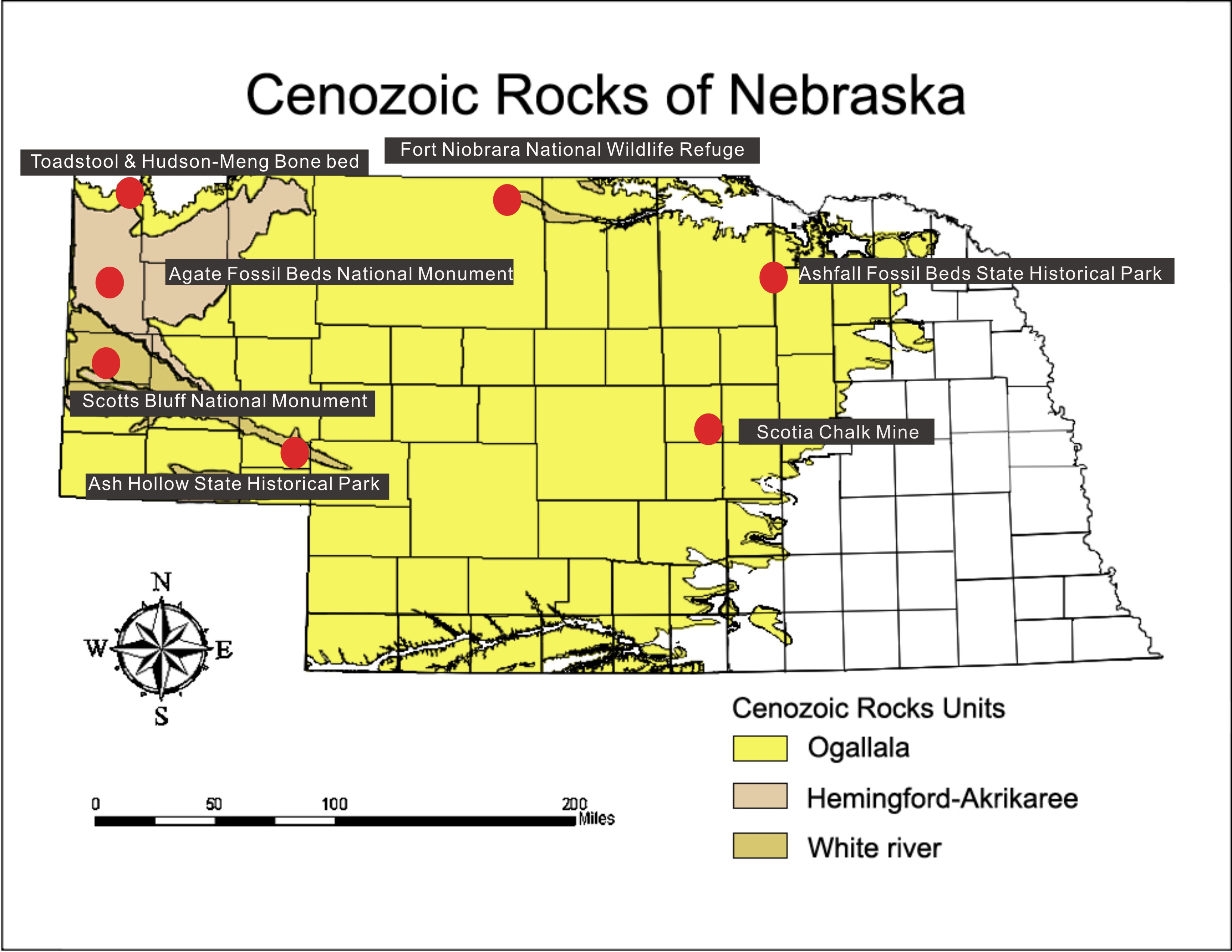Places in Nebraska to Visit Cenozoic Rocks

Toadstool Geologic Park and Hudson-Meng Bone Bed
Toadstool geologic park located in the Oglala National grassland in
northwestern Nebraska. It is a good location to see Badlands
topography and rocks of the White
River group. In the northern part of the park, there is a visible fault that
can be seen from the main hiking trail. Nearby (to the south) is the Hudson-Meng bone bed, which is a good location to
see the largest
bison bone bed in North America. Similar to Ashfall State Historical Park (see below), these bison were all killed in a single unknown event.
For more information about visiting Toadstool geologic park, click HERE; for Hudson-Meng Bone Bed, click HERE.
Agate Fossil Beds National Monument
Agate Fossil Beds National Monument is a good place to see the Arikaree group. Good exposures of rock can be found following the
main trail road within the park. Arikaree-age fossils such as two-horned rhinoceros, horses, camels and the oreodonts (related to camels) have been found in the park.
For more information about visiting Agate Fossil Beds National Monument, click HERE.
Scotts Bluff National Monument
Scotts Bluff National Monument is located in the far western part of Nebraska, near the Wyoming-Nebraska state line. This park is another great place to see rocks of the Arikaree Group, which form massive bluffs. Similar to Agate Fossil Beds National Monument, Arikaree-age fossils such as two-horned rhinoceros, horses, camels and the oreodonts (related to camels) have been found in the park.
For more information about visiting Scotts Bluff National Monument, click HERE.
Ash Hollow State Historical Park
Ash Hollow State Park is located at the western end
of Lake McConaughy. The Ash Hollow bluffs are covered by the Ash
Hollow Formation of the Ogallala group. It is the great location to see
Lake Diffendal, as well as Pleistocene-age river channel and floodplain deposits.
For more information about visiting Ash Hollow State Historical Park, click HERE.
Scotia Chalk Mine
The Scotia Chalk Mine is a great place to see terrestrial chalk deposits, which form bluffs near the small town of Scotia (central Nebraska). Normally, chalk forms in the deeper parts of the oceans, but occasionally chalk can form in lake deposits, such as the Scotia Chalk. The chalk is part of the Ogallala group and small clams and snails have been found in the bluffs.
For more information about visiting Scotia Chalk Mine, click HERE.
Ashfall Fossil Beds State Historical Park
Ashfall Fossil Beds State Historical Park is located 8 miles north of
U.S. 20 in north-central Nebraska. Numerous Ogallala-age mammal remains are found in the park. These animals all died as a result of a catastrophic volcanic eruption in Idaho, which deposited several feet of ash in Nebraska within a few days. The site of Ashfall is thought to have been a watering hole where the animals congregated as they desperatelytried to escape the volcanic ash. Although the Ashfall story represents a tragic event in Earth's past, scientists have been able to learn a great deal about the climate, plants, and animals of Nebraska during the Miocene.
For more information about visiting shfall Fossil Beds State Historical Park, click HERE and HERE.
Fort Niobrara National Wildlife Refuge
Fort Niobrara National Wildlife Refuge is located a few miles east of
Valentine in north-central Nebraska. Some great cliffs exposing rocks of the Ogallala and Arikaree Groups can be seen
along the Niobrara river valley.
For more information about visiting Fort Niobrara National Wildlife Refuge click HERE.
For more information about geology locations in Nebraska, see Maher, H., Engelmann, G., and Shuster, R., (2003 and references therein), Roadside Geology of Nebraska, Mountain Press Publishing Company, p103-125; p173-193 and p227-240.